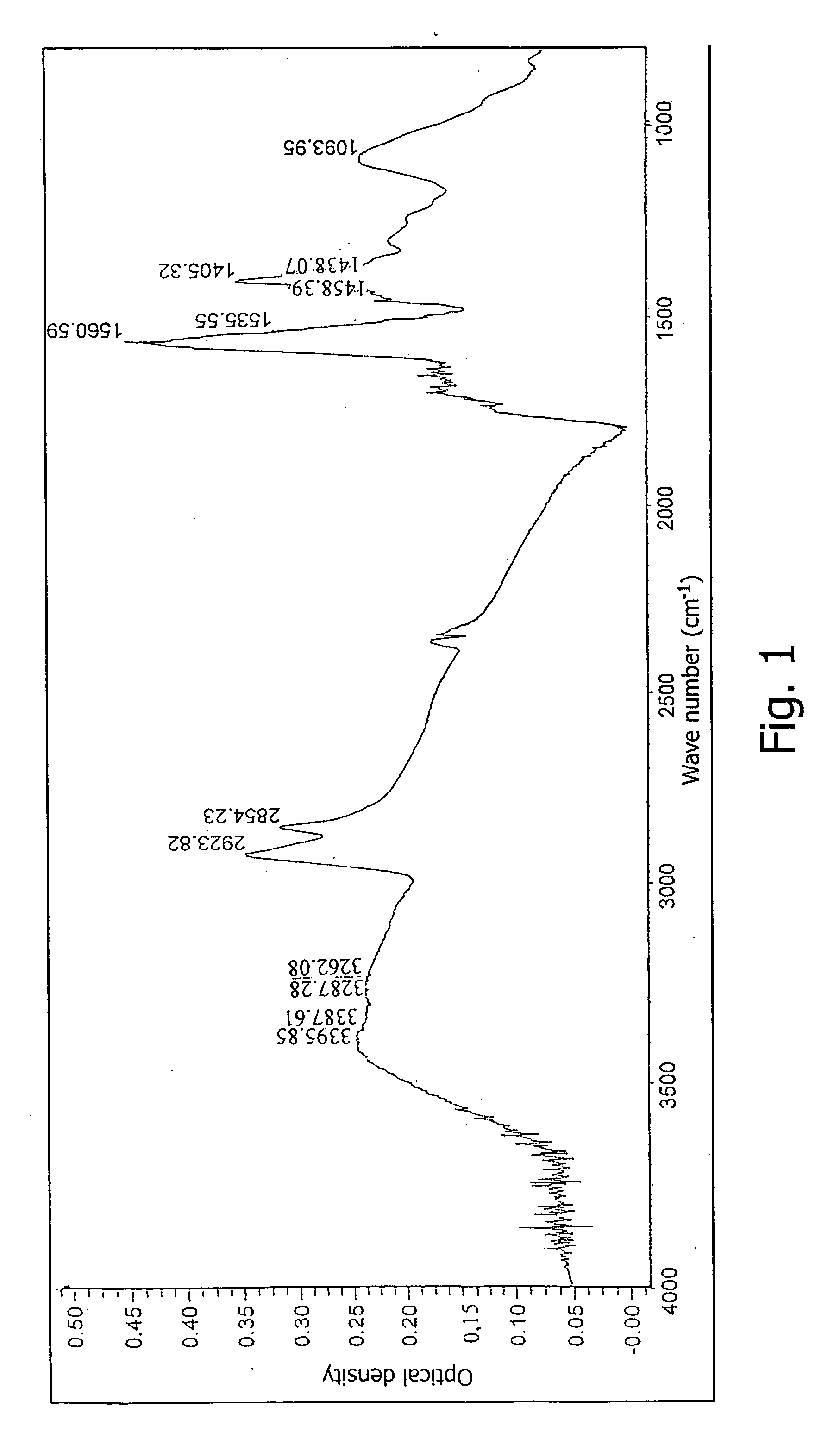Agent for inhibiting membrane virus reproduction, method for the production thereof, pharmaceutical composition and method for inhibiting viral infections
a technology of membrane virus and antiviral activity, which is applied in the field of pharmaceutical industry, can solve the problems of unfavorable side effects, insufficient proof of efficiency, and complicating the chemotherapy, immunotherapy and vaccinal prevention of aids, and achieves the effect of lowering the level of virus antigen and demonstrating antiviral activity with respect to hiv-1
- Summary
- Abstract
- Description
- Claims
- Application Information
AI Technical Summary
Benefits of technology
Problems solved by technology
Method used
Image
Examples
example 1
Synthesis. Characteristic of Some Compounds of Formula (I).
[0099] A 2.5 g batch of fullerene is dissolved in o-dichlorobenzene (o-DCB), and half of the volume of PEG-500 and potassium salt of aminocaproic acid in the 1:1 mole ratio with PEG is added. The reaction mixture is maintained for at least 4 hours at the temperature of 70° C. with stirring. The solvent is removed and the precipitate is dried till the odor of o-DCB disappears. The compounds in acidic form are prepared by adding about 120 ml of 8% hydrochloric acid, pH 5.0, and in salt form by dissolving in 0.1 N sodium hydroxide, pH 7.0. The yield: 5.6 g of the product, 224% in terms of the taken fullerene.
[0100] A 360 mg batch of fullerene is dissolved in toluene. 16 g of potassium salt of aminobutyric acid and 50 g of PEG-500 are introduced into the solution. Then the procedure is continued as described above. The yield: 540g, 150% in terms of the taken fullerene.
[0101] The solubility of fullerene and of its derivatives ...
example 2
[0102] Spectrometric investigation in the IR spectral region of compounds of formula (I) in the form of acid or of their sodium salts was carried out in a disk with KBr. Fort this purpose 1 mg of the preliminarily dried preparation was mixed in a mortar with 150 mg of spectrometrically pure potassium bromide and the mixture was compacted at a pressure of 7.5-10 cm−1 for 2-5 min.
[0103] The spectrum of the obtained sample was recorded on a NICOLET “AVATAR 320-FT.IR” IR spectrometer, USA with NICOLET EZ OMNIC software, USA. Spectral parameters: resolution, 4 cm−1; format—optical density; range, 399-4000 cm−1; sampling frequency, 1.929 cm−1. The spectrum was treated by correcting the H2O / CO2 line (FIG. 1). Concurrently under the same conditions the IR absorption spectra of fullerene and of the amino acids used in the synthesis were recorded.
[0104] For confirming the presence of the amino acid and fullerene in the claimed compounds, the method of subtracting spectra was employed with s...
example 3
TLC. Separating Compounds of Formula (I) by TLC Technique
[0105] Test solutions of compounds of formula (I) are prepared: of sodium salts of fullerene-polyamino-caproic acid, of fullerene-polyamino-butyric acid and of fullerene-polyamino-octanoic acid in water with the concentration of 1 μg / ml. Fullerene is dissolved in toluene.
[0106] 10 μl (10 μg) of the test solutions are applied to the starting line of a 10×15 cm Silufol chromatographic plate with a 0.1 mm-thick layer.
[0107] The plate is dried in the air for 10 min., then placed into a chamber with a mixture of solvents alcohol benzene: 96% alcohol:water (1:4:1.5) and chromatographed by the ascending technique. When the front of solvents has passed about 10 cm from the starting line, the plate is removed from the chamber and dried in the air for 20 min.
[0108] Three spots with Rf=0.82, 0.71, 0.47 are found on the chromatogram: 0.47 for fullerene-polyamino-caproic acid, 0.47 for fullerene-polyamino-butyric acid, and 0.82 for ful...
PUM
| Property | Measurement | Unit |
|---|---|---|
| Temperature | aaaaa | aaaaa |
| Fraction | aaaaa | aaaaa |
| Solubility (mass) | aaaaa | aaaaa |
Abstract
Description
Claims
Application Information
 Login to View More
Login to View More - R&D
- Intellectual Property
- Life Sciences
- Materials
- Tech Scout
- Unparalleled Data Quality
- Higher Quality Content
- 60% Fewer Hallucinations
Browse by: Latest US Patents, China's latest patents, Technical Efficacy Thesaurus, Application Domain, Technology Topic, Popular Technical Reports.
© 2025 PatSnap. All rights reserved.Legal|Privacy policy|Modern Slavery Act Transparency Statement|Sitemap|About US| Contact US: help@patsnap.com



